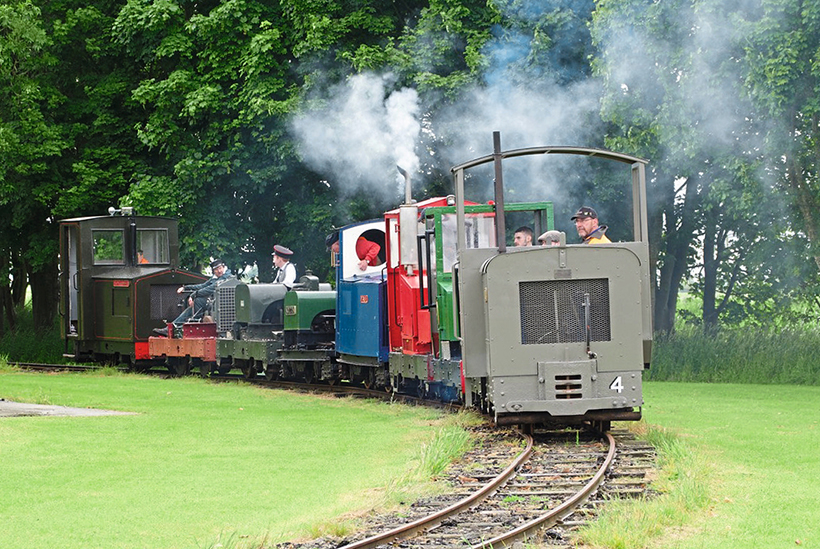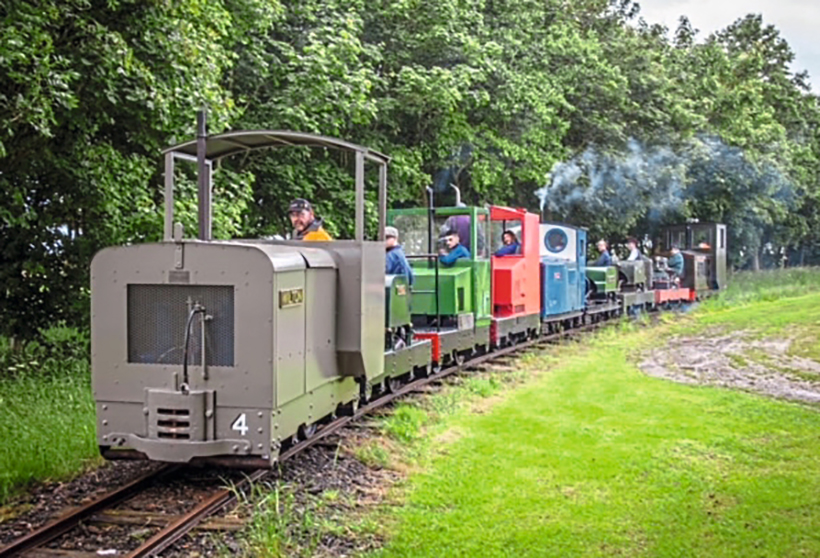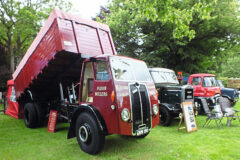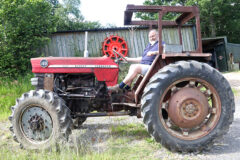Lincolnshire Coast Light Railway diesel day cavalcade
Posted by Chris Graham on 21st August 2024
We report on the very successful diesel day cavalcade that was held at the Lincolnshire Coast Light Railway.

Lincolnshire Coast Light Railway: The cavalcade rounds the curve approaching Walls Lane terminus, returning from South Loop. (Photo: John Raby/LCLR)
Enthusiasts travelled to the Lincolnshire Coast Light Railway from all over England to witness all nine of its Simplex diesel locomotives in a cavalcade that formed the highlight of its Diesel Day, when no fewer than five of the LCLR’s heritage diesels worked passenger services for the first time in the railway’s 64-year history, on Saturday 15th June, 2024.
A quick look at the calculator showed the combined age of the locos to be 769 years; the oldest, Nocton, (fleet #7) was built in 1920 while the youngest is Fred, which survived inundation in the East Coast Floods at Mablethorpe in 1953. It was built in 1947 and finished its working life at Skegness Brickworks.

Making its first main line outing only a week after the engine was first fired-up as part of its restoration, #8905 and #6 – both moving on to the main line at Walls Lane station ready for their first passenger working. (Photo: John Raby/LCLR)
By carefully devised combinations with the other, air-braked locomotives normally used on timetabled passenger services, it was possible for passengers to enjoy journeys powered by:
• a 1941 Simplex (the LCLR’s No.6)
• Fred
• Sark – 40hp Simplex fitted with an air-cooled engine, normally used for shunting, which had been acquired from Bolton Fell Peatworks, in Cumbria
• A privately-owned Simplex (builder’s number 8905) which had only fired-up its replacement engine one week earlier, as part of a multi-year restoration project
• ‘T3’, a 1942-built Simplex, now fitted with an air-cooled engine, originally supplied to a firm in Midlothian, which has recently undergone substantial overhaul on the LCLR

Wilton heads the cavalcade of nine locomotives returning from South Loop. (Photo: Andy Stevens/LCLR)
The designs go back to the trench railways of the First World War, intended and built for moving train-loads of soldiers, armaments, water, medical supplies and fodder for horses over the notoriously deep and dangerous mud, which would otherwise have prevented access to the trenches and the fighting.
Those designs were adapted and modified over the years by the builders, Motor Rail Ltd of Bedford – using the brand name ‘Simplex’ – and, in 2024, they are proving just as reliable, sturdy and useful. The basic design, with some modifications, continued to be built up to, during and after the Second World War. The firm survived until 1992, when its business largely involved building Simplexes for use in South African mines. They proved particularly useful in Lincolnshire, moving heavy loads of potatoes, sugar beet, fertiliser, clay, bricks and timber – as well as holidaymakers – until improving roads and road vehicles made them redundant.
Chairman of the LCLR’s supporting Historic Vehicles Trust, Richard Shepherd, said: “We spoke to visitors who told us they had travelled from as far as Kent, Windsor, Gloucestershire, the Ffestiniog Railway, Manchester and Preston, as well as the East Midlands and Yorkshire, to participate.

Volunteer Paul Galyer hooks Fred to its first-ever passenger service. (Photo: John Raby/LCLR)
“It’s clearly a highly specialised area of interest within the wider range of enthusiasms for railways, but everyone seemed to think it well worth the journey to Skegness to participate, and we are very grateful for their support.
“It was the culmination of a lot of work to restore these sturdy and reliable machines to working order, and to be able to showcase them to the public.”
A video of the event by LCLR volunteer John Raby is available to view at: https://tinyurl.com/LCLRDieselGala
This feature comes from the latest issue of Old Glory, and you can get a money-saving subscription to this magazine simply by clicking HERE

Previous Post
Father’s Day commercial vehicle gathering at Bressingham Hall

Next Post
A very interesting and historic Massey Ferguson 165



